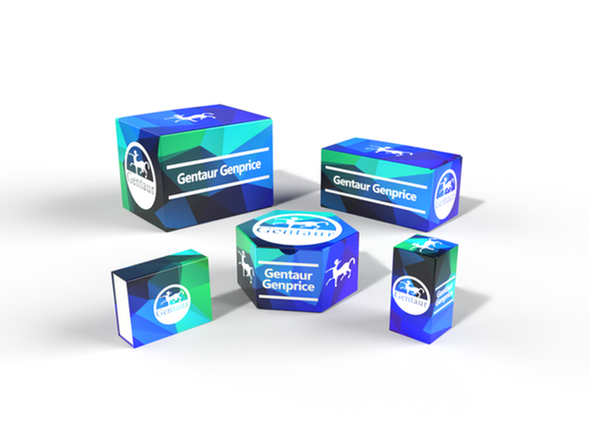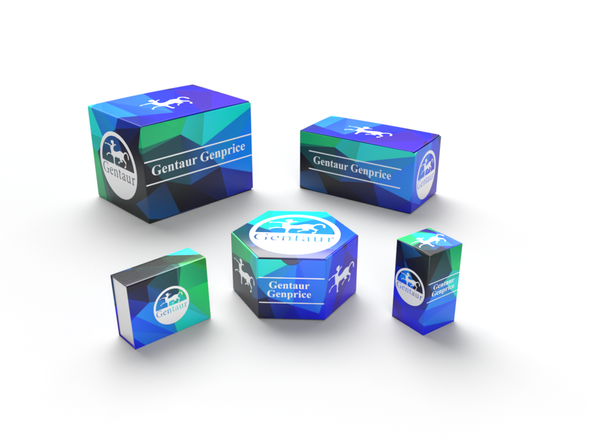Description
IRAK-4 Antibody | 3125 | Gentaur UK, US & Europe Distribution
Host: Rabbit
Reactivity: Human
Homology: Predicted species reactivity based on immunogen sequence: Bovine: (85%) , Mouse: (85%) , Rat (77%)
Immunogen: Anti-IRAK4 antibody (3125) was raised against a peptide corresponding to 13 amino acids near the carboxy terminus of human IRAK4.
The immunogen is located within the last 50 amino acids of IRAK4.
Research Area: Signal Transduction,
Tested Application: E, WB, ICC, IF
Application: WB: 1-4 μg/mL; ICC: 10 μg/mL; IF: 10 μg/mL.
Antibody validated: Western Blot in human samples; Immunocytochemistry in human samples and Immunofluorescence in human samples. All other applications and species not yet tested.
Specificiy: IRAK-4 antibody is predicted to not cross-react with other members of the IRAK protein family.
Positive Control 1: Cat. No. 1204 - K562 Cell Lysate
Positive Control 2: Cat. No. 1201 - HeLa Cell Lysate
Positive Control 3: Cat. No. 1224 -Daudi Cell Lysate
Positive Control 4: Cat. No. 1211 -HepG2 Cell Lysate
Positive Control 5: Cat. No. 17-004 - K-562 Cell Slide
Positive Control 6: N/A
Molecular Weight: Predicted: 52kD
Observed: 55 kD
Validation:
Independent Antibody Validation in Cell lines (Figure 2) shows similar IRAK4 expression profile in human cell lines detected by two independent anti-IRAK4 antibodies that recognize different epitopes, 3125 against C-terminus domain and 24-025 against recombinant fusion protein. IRAK4 proteins are detected in the most tested cell lines at different expression levels by the two independent antibodies.
KO validation (Figure 6) : Anti-IRAK4 antibody (3125) specificity was further verified by IRAK4 knockout and mutant mice. IRAK4 signal in the macrophages of IRAK KO mice and mutant mice was disrupted as compared to wild type mice.
Regulated expression validation (Figure 7) : IRAK4 expression detected by anit-IRAK4 antibodies (3125) was reduced with CSK-4 treatment, which was rescued by proteasome inhibitors.
KD validation (Figure 8) : Anti-IRAK4 antibody (3125) specificity was further verified by IRAK4 knockdown. IRAK4 signal was disrupted in HEK293T cells transfected with IRAK4 siRNAs.
Isoform: Human IRAK4 has 2 isoforms, including isoform 1 (460aa, 52kD) and isoform 2 (336aa, 38kD) . Mouse IRAK4 has one isoform (459aa, 51kD) and Rat IRAK4 also has one isoform (461aa, 51kD) . 3125 can detect human isoforms as well as mouse and rat IRAK4.
Purification: IRAK-4 Antibody is affinity chromatography purified via peptide column.
Clonality: Polyclonal
Clone: N/A
Isotype: IgG
Conjugate: Unconjugated
Physical State: Liquid
Buffer: IRAK-4 Antibody is supplied in PBS containing 0.02% sodium azide.
Concentration: 1 mg/mL
Storage Condition: IRAK-4 antibody can be stored at 4˚C for three months and -20˚C, stable for up to one year. As with all antibodies care should be taken to avoid repeated freeze thaw cycles. Antibodies should not be exposed to prolonged high temperatures.
Alternate Name: IRAK-4 Antibody: IPD1, REN64, IRAK-4, NY-REN-64, Interleukin-1 receptor-associated kinase 4, Renal carcinoma antigen NY-REN-64
User Note: Optimal dilutions for each application to be determined by the researcher.
BACKGROUND: IRAK-4 Antibody: Interleukin-1 (IL-1) and lipopolysaccharide (LPS) induces cellular responses through IL-1 receptor (IL-1R) and Toll-like receptors (TLR) . IL-1R-associated kinases (IRAK, IRAK2, and IRAK-M) regulate the activation of NF-κB and MAP kinase (MAPK) by IL-1R/TLR. A novel member in the IRAK/Pelle family was recently identified and designated IRAK-4. Overexpression of IRAK-4 activates NF-κB and MAPK pathways. IRAK-4 interacts with and phosphorylates IRAK-1. IRAK-4-deficient animals are completely resistant to the challenge with LPS. Animals and humans lacking IRAK-4 are impaired in their responses to viral and bacterial challenges. Members in IRAK/Pelle family play a central role in IL-1R/TLR mediated inflammatory responses and in innate immunity.










